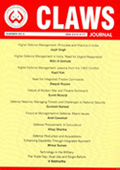|
In the just concluded elections in South Chhattisgarh, nearly three million voters exercised their franchise for electing their representatives in 18 assembly constituencies. Both men and women disdainfully ignored Maoist warning of chopping the fingers of those who dared to cast their vote. Rather, the voting percentage of tribal women was as high as 90 percent in certain segments. This is not the first time that people of the region in an area of 40,000 sq km, larger than the state of Kerala, have defied the Maoists election boycott call. An assessment of voting figures in the worst Maoist affected areas indicates that the voting percentages in majority of areas have increased when compared to 2008, while there has been marginal drop in two regions, i.e. Bijapur and Bastar:
{C}{C}{C}{C}{C}{C} {C}{C}{C}{C}{C}{C}{C}{C}{C} {C}{C}{C}{C}{C}{C}{C}{C}{C}
.html) 
In terms of overall voting percentages in the 18 constituencies, there has been an improvement, even if marginal from 66.9 percent in 2008 to 67 percent in 2013. It can be construed from the voting figures that the level of enthusiasm in the democratic process has not flagged since 2008. In both the years, the overall voting percentages have remained impressive going by the national average. Therefore, the theme flogged by Maoist apologists of tribal veering away from national mainstream is humbug. It also busts the Maoist pretensions of popular following.
Further, traversing from South to North, the voting percentages increase because of attenuation of Maoist writ. The marginal slide is in the southern areas, i.e. Konta and Bijapur, in the forested belt reeling under Maoists terror. However, in the same region in the urban areas such as Dantewada, which have the succor of the writ of the state, the voting percentage has been 67percent, an increase of 12percent from 2008. There is no yawning difference between 2008 and 2013 in any of the electoral segments enumerated above. The people therefore have been unmistakably steadfast in their commitment to national mainstream and democracy; it is the State that must do more to secure their aspirations.
The public mood and anger against the Maoists is evident from the voting figures of 2008 and 2013. Nearly 70 percent voting can be considered overwhelming but such is the viciousness, dread and monopoly over violence of the Maoists, that it is their terror that has overwhelmed the population. The impact of Maoist terror on the elections was obvious as 4142 booths in 18 constituencies were declared sensitive, which included 1,311 hypersensitive ones. There was no voter turnout in as many as 42 booths. Due to Maoist threat, polling parties could not reach two booths in Antagarh, south of Kanker. In Chhattisgarh as such, out of 21,442 stations, 6,922 have been declared sensitive and 3,249 hypersensitive. This reveals a grim security scenario in the state owing to Maoist terror. The Election Commission shifted as many as 167 polling booths in Bastar due to Maoist threat. Nearly 7,000 voters were expected to trudge 15-50 km in the Abhujmarh area, which covers around 3900 sq km of forest land. It is for these reasons that the voting percentages in the so-called Maoist liberated zone have been low. It may also be mentioned that none of the candidates dared to canvass in Abhujmarh and Narayanpur.
The level of security preparations was unprecedented. Nearly one lakh security personnel were deployed to conduct elections in 18 constituencies, which translates into roughly two Lok Sabha constituencies. Security personnel constituting more than 500 companies of para-military and CRPF were put through a 15-days jungle warfare course for conduct of the polls. Each booth had two tier security. Helicopters and UAVs were put to use, the latter for the first time for conduct of election. Despite these security arrangements, there were 14 Maoist attacks to disrupt polling. Nearly 80 IEDs were recovered from the poll zone. Security personnel and polling parties studiously avoided vehicular movement and kept away from roads.
This large deployment indicates that the level of Maoist terror since 2008 has not abated rather amplified, even as democratic and nationalistic aspirations of the people have been treated as ‘seasonal’ by the Indian State. Nevertheless, the redeeming aspect is that the overall voting percentages have remained nearly the same. It means that people are crying to be rescued by the State. It was these very courageous people, who had banded together to form the ‘salwanjudum’. If people have not been dissuaded by diktats of the Maoists to boycott elections, it means that they are desperate to break free from Maoist shackle imposed by its leadership, which is largely from Andhra Pradesh and West Bengal.
The magnitude of ‘boots on ground’, amounting to five divisions of the Army, when considered purely in terms of number of personnel, shows that the Union Government is acutely aware of the level of threat posed by the Maoists. This makes it incumbent on the state to ensure protection of the populace post the elections.
The State’s failure to eliminate Maoist terror has engendered symbiotic relationship between certain political parties, politicians and the Maoists, to influence the course of elections in the Maoist Corridor running euphemistically from Tirupathi to Pashupathi. Maoists in fact have become a violent leverage in the electoral politics of India. As per some reports, a Speaker of a Legislative Assembly is widely believed not to be a merely a supporter but an active Maoist. The ruling party of another state owes more than half its seats to Maoists. One Chief Minister deliberately refuses to acknowledge the Maoist terror even as more than 30 of his districts fall within the Red Corridor. A Member of Parliament from Odisha in pursuit of religious agenda was allegedly involved in killing of a social worker Laxminanda Sarasawati in collusion with the Maoists. In addition, the foregoing elections in southern Chhattisgarh, were conducted in the shadow of murder of 27 people by Maoists in an ambush on May 25, 2013 in the Darbha Valley in the Sukma district. These people were participating in a political rally, a perfectly legitimate democratic activity. The killed included Mahendra Karma, a tribal leader and V.C. Shukla, a former Union Minister. Both were redoubtable politicians. These killings smacked of a political rival plot and the region is abuzz about the involvement of one particular politician, a CM aspirant.
Maoism is thus gradually eroding the vitals of parliamentary democracy in India. The people defied Maoist terror in Chattisgarh in overwhelming numbers because of their faith in democracy, made possible by unprecedented security intervention of the State. It also shows that Maoists do not enjoy popular support and that Maoism in India sustains on ‘terror’. If the people were to be really disenchanted with the State, then most of the voters would exercise the newly introduced ‘None of the Above (NOTA)’ option in the EVMs.
The Election Commission did in large measure temporarily reclaim the areas for conduct of election in the Red Corridor. But the imperative for democracy and development is ‘permanent’ and not ‘temporary’ writ of the State. The elections also suggest an ongoing struggle between democracy and Maoist envisaged totalitarian State, the latter being masterminded and spearheaded by few non-indigenous leaders and ideologues, enjoying respectability in garb of intellectuals. The tacit support of inimical external powers is dismissed by subverted interests or grudgingly factored by security planners and analysts.
The vested interests, who deny any external links of the Maoists in their endeavor to establish a totalitarian State, have to only look towards Nepal where the Chinese leadership have been alternately inviting both the Prachanda (pro-election) and Baidya (anti-election) group to China to chalk out two different routes for capture of State. Only a few devious heads need to be crushed to liberate people from Maoist terror in the Red Corridor. The choice before the Indian State is between a few heads of the Maoist leadership and democracy
RSN Singh is a Delhi based defence and strategic analyst.
Views expressed are personal
|



